The Roman spring is legendary. Southern Europe is warming up but the rest of the continent is just beginning to thaw. Schools are in session and the bulk of this summer’s visitors are still in the planning stages for their Roman holidays. It’s the perfect time to visit.
The last time M and I were here was October of 2003. We rode our bikes from the lakes in the north (Como and Maggiore), south to Milan then down through Tuscany and Umbria to Rome. It was a first-rate adventure but by October the locals were exhausted, tired of tourists, and looking forward to their own vacations. By then the weather had changed and our four days in Rome were rain drenched. It was an exciting trip, but this year is totally different; the weather is perfect, the people welcoming, and the city full of energy.
This is Piazza di Spagna (Spanish Steps) at 8:30 this morning. You rarely see it so empty. Our apartment is just four doors down the street to the left (Via del Babuino).
Italy and Rome are hugely dependent on the tourism. According to the Ministry of Foreign Affairs, it contributes approximately one-third to the Italian GDP annually, and UNESCO estimates that more than half of the world’s artistic and historic patrimony can be found at its countless archeological sites and more than 2000 museums. There is hardly an area that is not drenched in history and artifacts, monuments and great art.
Although summer is almost a month away, May is the beginning of high season and it’s the real reason we are splitting our time between two apartments. When we started our search in March, apartments were beginning to fill up and we couldn’t find just one place for the duration of our two months stay. We were disappointed at having to move during our stay, but it turned out to be a surprise advantage. The two apartments we’ve chosen are in two vastly different neighborhoods – Prati and Piazza di Spagna – and we are seeing two of the faces of Rome from the inside out.
Prati, our first neighborhood, is basically middle class and residential. Located just north of the Vatican, it includes the Vatican and St. Peter’s within its boundaries but there is very little tourist spill over. Walk two blocks north of the Vatican wall and you’re in a neighborhood free of restaurant touts, sunglass sellers and selfie-sticks. You rarely hear English spoken except by the waiters and bartenders, and there are no menus in four languages. There’s a real local feel to the neighborhood.
Our apartment in Prati was a bare bones unit with a bedroom just large enough for a double bed, sandwiched between a tiny kitchen and the small modern bathroom on the other side. It was cozy, adequate, and met our needs.
Its real advantage was its location. It was, as I said, a real neighborhood and within two days we were known and recognized by the grocer, the staff at “our” café, and the people at Ristorante Il Colibri on the corner. Within days we were familiar with the bus and Metro routes as well as most of the streets from St. Peter’s Square to Piazza Clodio where the Vodafone girls knew us from our repeated visits to get the Italian Sim cards working.
Prati was our base for a little over three weeks. Last weekend we said goodbye to Georgio and Lilyana at the Café NovecentoTredici, and moved operations to a larger apartment in the heart of the heart of the tourist area – Piazza di Spagna. The new living room is two stories tall with a sleeping loft above and a view of Roman rooftop gardens to the north.
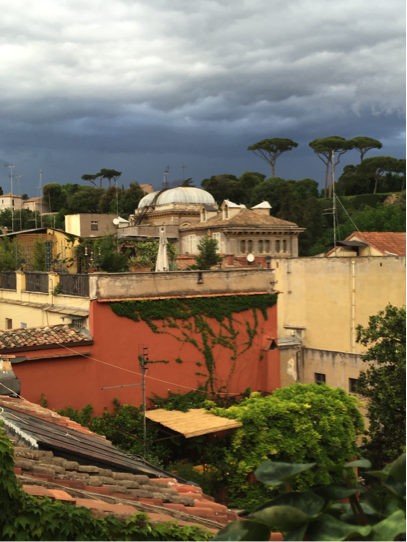 There’s one small, really small, drawback; the elevator is a vertical coffin for two. You should have seen us getting our bags up when we moved in. Size is only one of the “small” drawbacks, it’s so temperamental that if any one of its three doors is left ajar or opened prematurely the bells and whistles go off throughout the building. M was scolded mercilessly by one of the lower floor residents today and we’re both glad we didn’t have a word for word translation.
There’s one small, really small, drawback; the elevator is a vertical coffin for two. You should have seen us getting our bags up when we moved in. Size is only one of the “small” drawbacks, it’s so temperamental that if any one of its three doors is left ajar or opened prematurely the bells and whistles go off throughout the building. M was scolded mercilessly by one of the lower floor residents today and we’re both glad we didn’t have a word for word translation.
That’s it for the drawbacks. On the other side of the ledger, the entrance is four doors from Piazza di Spagna and a block from Via Condotti – Rome’s Rodeo Drive. There’s hardly a luxury brand that isn’t represented on its short, four-block length. Our apartment is on the 5th floor, over a Chanel store, across the street from Tiffany & Co., a stone’s throw from Missoni, and a block away from McDonald’s.
That’s it. You heard it right; Mickey D is right here in the heart of trendyland, just the other side of the Spanish Steps. But, this is not your fat cousin’s McDonalds. The entrance to Mickey’s takes you into a dark, sleekly designed espresso bar with fresh squeezed blood orange juice, and a pastry case (see below) full of tarts, cakes, and breakfast pastries.
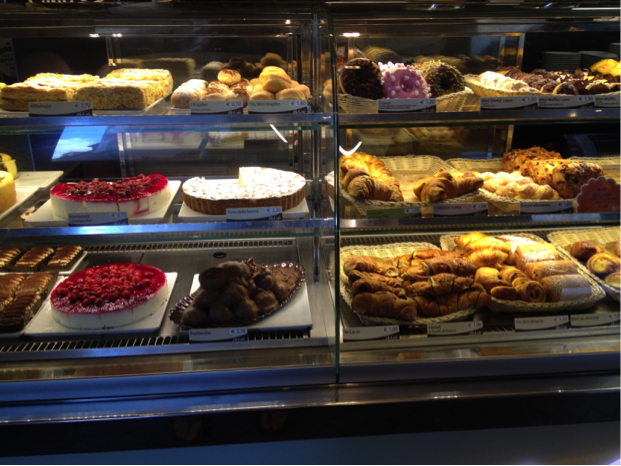 This is no Styrofoam and paper cup joint. The cappuccinos are served in big ceramic cups and the pastries come on plates. The tables are located in little alcoves with indirect lighting and a step above a cobblestone walkway that leads you to a stairway up to a mammoth restaurant space – also sleekly Italian in design.
This is no Styrofoam and paper cup joint. The cappuccinos are served in big ceramic cups and the pastries come on plates. The tables are located in little alcoves with indirect lighting and a step above a cobblestone walkway that leads you to a stairway up to a mammoth restaurant space – also sleekly Italian in design.
It’s been years since I was in a McDonald’s, but I have to tell you the cappuccinos here were well crafted, the croissants flaky, and the fresh squeezed juice sweet and pulpy. At 9.6 Euros for two of each, I think it might be our go-to spot for the next three weeks. The same breakfast up the street ran us 37 Euros ($40) on Sunday. And, McD also has a stunning gelato bar. A vacation in Rome is not about saving money at Mickey’s, but Rome’s influence on Mickey is duly noted and shouldn’t be lost on the observer. This is a city that is obsessed with food, fashion, design, and history.
Last year in Paris we were focused on seeing art and studying its history. We loved the markets and sidewalk cafés, but our attention was primarily directed to seeing the art and visiting the museums small and large that house the outstanding collections. This year we’re more involved in food and people watching. There is a different vibe here. People are fashionable but casual and the pace is slower. Life slows and the streets clear around lunchtime, and there are so many good places to eat and so many different ways to deliver it – bars, cafés, trattorias, pizzerias, tavola caldas, bistros, wine bars, ristorantes and even tearooms.
With walking as our only exercise it is a challenge to keep the Pillsbury Doughboy from taking over, but even though a true Italian meal includes antipasto, primi piatti, seconda piatti, dolci, and vino the portions are not American-sized and we usually manage to limit ourselves to splitting an antipasto and two primi, only eating one meal out. We have another month here, so we might have to avoid the scale when we get home. Here’s my motivation; I need to fit in this elevator for three more weeks – and get my bags down too.

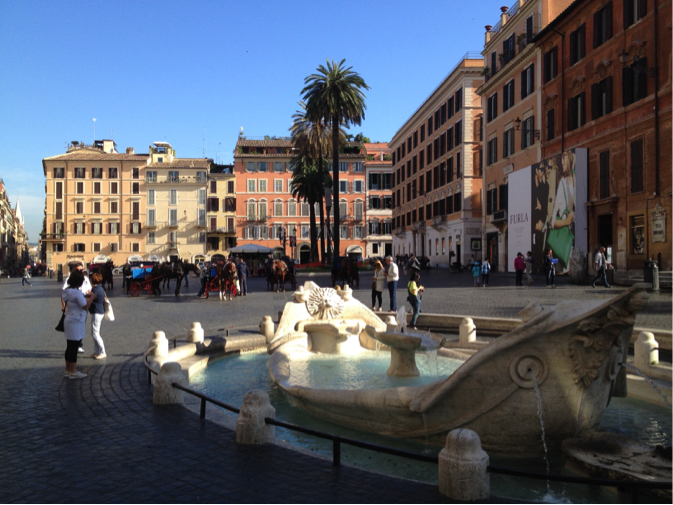
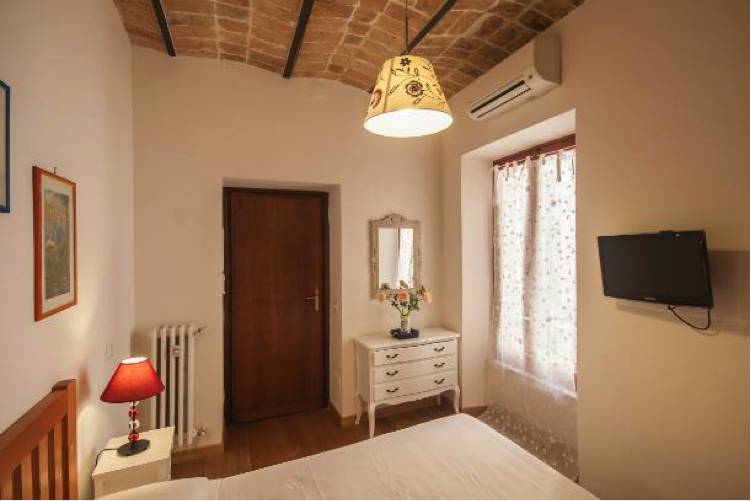
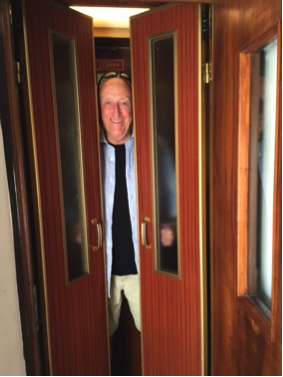
































Love reading about your adventures….looking forward to the next posting
Excellent way of explaining, and nice piece of writing to obtain information regarding my presentation subject, which i am
going to convey in academy.